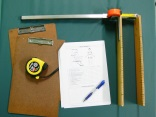State Spinal Cord Injury Service
Spinal Seating Modules

Measuring the client’s body
Body measurement is also referred to as anthropometric measurement. The measuring process should take a maximum of 10 minutes.
Preparation
- Be prepared by having the tools and the recording form within reach
- Consider having another person if possible to scribe the measurements or to assist with holding the clip board in position as a reference point
- The measuring calliper is a very useful tool when you are on your own.
- Body measurement can be conducted straight after the supine or sitting MAT assessments to reduce the number of client transfers, depending on the client needs (see below Risk Assessment and Safety Concerns)
- A general guide for conducting a body measurement
- For hands-free sitters and hands-dependant sitters who are able to maintain the required posture, sitting is the best position for the process
- For dependant sitters, measure in supine
- Refer to Timeline suggestion for assessment task
- Seating postural goals are established after the MAT process outlined in Module 3. The client should be measured according to this established desired posture.
Process
- Body measurement can be conducted straight after the supine or sitting MAT assessments to reduce the number of client transfers, depending on the client need. See also "Risk Assessment and Safety Concerns" below.
- A general guide for conducting a body measurement
- For hands-free sitters and hands-dependant sitters who are able to maintain the required posture, sitting is the best position for the process
- For dependant sitters, measure in supine
- Refer to timeline suggestion for assessment task
- Seating postural goals are established after the MAT process outlined in Module 3. The client should be measured according to this established desired posture.
Risk assessment and safety concerns
The body measurement process may be modified to ensure client and staff safety. Consider the following risk factors:
- Sitting balance
- Muscle spasms
- Large or heavy clients
- Unstable or soft assessment surface, and
- Pressure injuries or wounds: an existing wound should not be placed in contact with firm support surface during assessment, in seating or lying.
Risk reduction strategies for measuring the client’s body
- Consider involving a second assessor or helper if there are any manual handling risks or safety concerns during the body measurement process.
- Measure in supine or use a firm sitting chair for those who:
- are dependant sitters
- are unable to maintain the required sitting posture without assistance from another person
- have safety concerns with sitting due to spasm (e.g. hips and knees in extension spasm pattern)
- Measure in supine for clients with pressure injuries under the pelvis
- In the community setting, a padded firm sitting chair (e.g. dining chair) or a full length transfer board over a soft bed can be utilised as an assessment surface.
Note
Remove the board once the assessment is complete to prevent skin breakdown. Do not use the transfer board as the assessment surface if the client has a wound that is in direct contact with it.
 Helpful Equipment:
Helpful Equipment: